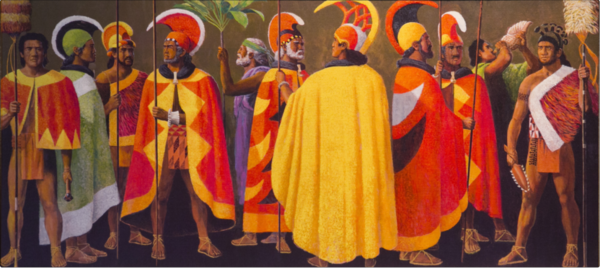The royalty (Ali'i in the Hawaiian language) in ancient Hawaii were revered for their knowledge, bravery and mana. To designate each chief's rank within the tribe, feather cloaks ('ahu'ula) and feather helmets (mahiole) were worn. The feather cloaks would be longest for the Ali'i Nui or high chief. In ancient Hawaii, feathers were a symbol of royalty. Each feather cloak had a unique color pattern/design and were made from the colorful feathers of Hawaii's native bird species. The most rare of all feathers was the yellow feathers of the Hawaiian Mamo (Hawaiian Honeycreeper). Thus, the more yellow that appeared in an 'ahu'ula, the higher the rank of the chief. Hawaiian legend says that Kamehameha I was the only Hawaiian chief known to wear a cloak comprising only yellow feathers.
The Hawaiian 'Ahu'ula are constructed of some of the finest feather work techniques in history. Some Hawaiian feather cloaks were said to contain millions of feathers and weigh upwards of 40 pounds. Other than a sign of rank, these 'ahu'ula also served as protection for the Hawaiian royalty. In battle, feather cloaks were known to deflect spears and other ancient weaponry.
"Na Hulu Ali‘i" is the largest-ever exhibition of Hawaiian feather work. This exhibit can be seen at the Bishop Museum in Honolulu. For more information about Hawaiian feather work and other Hawaiian artifacts, please visit the Bishop Museum website at http://www.bishopmuseum.org.








 RSS Feed
RSS Feed